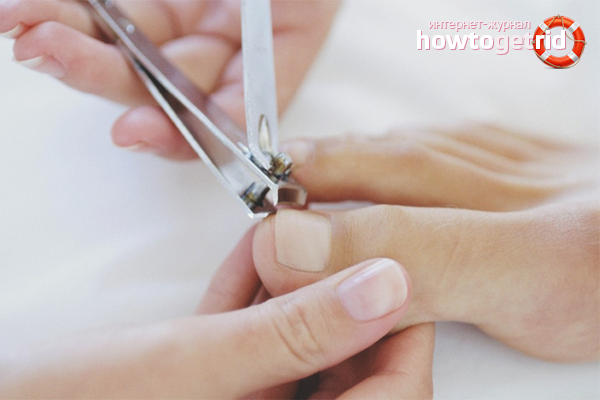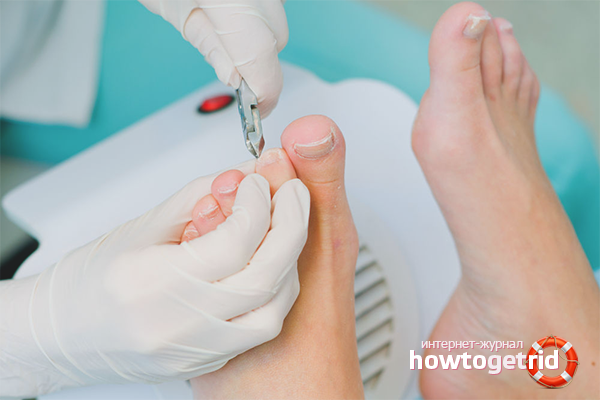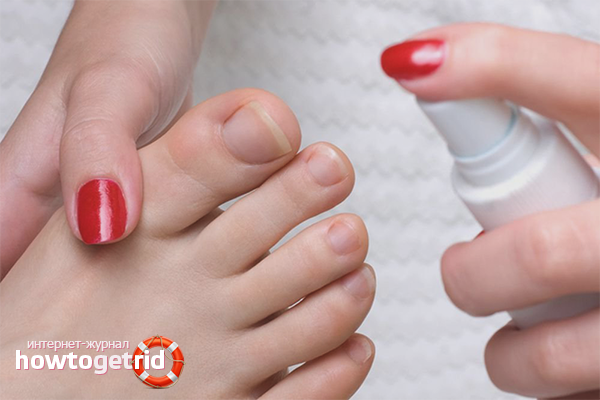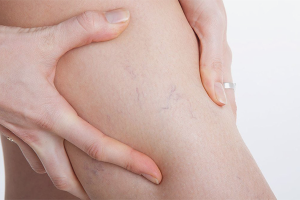The content of the article
Onychocryptosis is a disease associated with a violation of the growth of the nail plate and its introduction into soft tissues. Usually, ingrowth occurs from the lateral part of the nail, and is accompanied by swelling, redness and the onset of the inflammatory process. Possible tissue necrosis, sepsis, cyanosis of the finger. Onychocryptosis is successfully treated, and the problem cannot be triggered. If the disease arose in patients with diabetes mellitus, then the lack of proper treatment leads to gangrene and amputation. In a person with a weakened immune system, the inflammatory process at the site of the ingrown nail will develop into blood poisoning. Pathology of the nail plate can spread to the bones of the foot. A healthy person at least will not be able to walk normally and wear beautiful shoes. As a maximum, he will have a difficult operation and a long recovery period. But we are talking about neglected cases. Onychocryptosis is treatable and the problem can be resolved.
From which the nail grows into soft tissues
Onychocryptosis according to the International Classification of Diseases has the code L60.0 and belongs to the class of diseases “Diseases of the skin and subcutaneous tissue” (L00-L99) and belongs to the block “Diseases of the skin appendages” (L60-L75). Those. this is not a disease of bone tissue, but the problem is removed surgically, and the treatment is carried out by a dermatologist. Do not seek help in pedicure or manicure rooms. They, of course, will fix the problem, but they will not be able to prescribe competent treatment, and relapse is possible.
The nail grows for the following reasons:
- Incorrectly done pedicure (manicure). The nail should be cut no deeper than the nail pad. Do not trim the corners of the nail plate. It should be treated with a file. The sharp edge of the nail can grow, causing inflammation of the skin.
- Finger injuries. If the nail is deformed, a heavy object falls on it, the nail plate is injured, even the smallest wound gets an infection. The inflammatory process begins, which is accompanied by a violation of the skin renewal process. Soft tissues begin to grow uncontrollably, pathological granulation ("wild meat") is formed. Walking causes unbearable pain.
- Anatomically uncomfortable shoes. A high heel and a narrow toe increase the strain on the fingers. Nails become vulnerable, redness and pain are felt.
- Fungal diseases of the nail. The nail plate softens and deforms. It rests on the nail roller, causing irritation to the flesh.
- Foot disease. Any disease accompanied by a violation of blood supply affects the condition of the nail plate. It curls, becomes corrugated and uneven, causing nail ingrowth.
- Overweight and pregnancy. Being overweight increases the load on the feet, disrupting blood circulation. During pregnancy, the legs swell, causing the growth of the subungual tissue.
- Chemotherapy. Treatment of cancer disrupts the hormonal background, uncontrolled cell growth begins, including under the nails. Also, during chemotherapy, calcium is washed out, which affects the quality of the nail plate.
Symptoms of nail ingrowth
Not always an ingrown nail causes serious problems. With the beginning of the spring-summer season, women throw tractor-soled boots far into the closet and switch to model shoes. A high heel transfers body weight to toes.This affects the condition of the nails, and can provoke their ingrowth. In this case, the finger swells, reddens, becomes warm to the touch, pressure and a slight pulsation are felt. But talking about serious manifestations of the disease is necessary when a yellowish liquid is released at the place where the nail touches the skin or “wild meat” appears. The ripple becomes pronounced, as if a splinter fell under the finger. This means that the inflammatory process has begun, and the infection has got into the wound. Untimely treatment can lead to infection of the bone and even amputation of the finger.
Serious consequences may arise:
- lymphangitis or the spread of infection from a wound near an ingrown nail to the lymph nodes
- finger phalanx abscess
- osteomyelitis or spread of infection to the bone tissue of the finger
- gangrene or necrosis of finger tissue
Surgical Methods for Removing Ingrown Nail
- Removing part of the ingrown nail. Not only the ingrown nail, but also the soft tissue around it is removed. An open wound is formed, because the nail growth rate is 1 cm in 3 months. Patients suture and dressings. Given this, the operation should be carried out in the summer, when you can wear open shoes. Wearing shoes with closed boots and boots will cause pain.
- Laser surgery This is the most effective and painless method. A part of the ingrown nail and “wild meat” are removed with a laser. No need to suture and dressings, so the recovery process is several times faster. The operation can be performed at any time of the year. The main advantage is the exclusion of relapse, in contrast to traditional surgical intervention. The edge of the nail is sanded and it will not grow anymore.
- Correction plates. Special staples and springs are applied over the nail, which within 2-3 weeks raise the ingrown edge of the nail. The plates are varnished, they do not interfere with wearing shoes and are not accompanied by painful sensations. After separating the ingrown nail, it is cut off. The procedure is completely painless, it is possible when there is no inflammation of the soft tissues.
- Tamponade. The method consists in placing between the nail plate and the soft tissues of a swab with an antiseptic solution. The nail gradually takes its usual shape. However, tamponade is effective in the mild course of the disease.
The use of drugs in the treatment of ingrown nails
- PEDILEN fluid. Disinfects and relieves inflammation of the nail roller. It removes pain and stops swelling, improves the structure of the nail.
- Means for softening the ingrown nail Scholl’s has a convenient applicator brush with which the drug is applied to the nail plate, softening it.
- Ointment "Nogtinorm." Used after holding therapeutic baths for the feet. Relieves redness and inflammation of the soft tissues, removes the pressing sensation and pulsation. The ingrown nail itself is leveled in 10-14 days.
- Cream "Fundizol" consists of plant components (oak bark extract, salicylic acid). Relieves pain and discomfort, disinfects and helps get rid of infection. The nail softens and rises from under the tissues.
- Softener for nails SUDA. It contains organic acids and propylene glycol, due to which the nail quickly softens, and the periungual tissue calms down. Professional tool for preparing ingrown toenails for surgical removal.
- CAMILLEN 60 chamomile extract. Panthenol, which is part of the preparation, accelerates tissue healing, chamomile extract relieves inflammation. The tool is used to prevent nail ingrowth.
- Cream "Shark fat and succession" is a natural remedy. After steaming, it is applied to the ingrown nail and wrapped with a bandage. After a week of use, inflammation disappears and the nail plate is leveled.
Treatment of ingrown nail with folk remedies
- Tamponade with butter. After steaming, a piece of butter is placed on the nail, the area is wrapped with a bandage and cellophane. After 24 hours, the lotion is removed, and a tampon dipped in butter is applied under the ingrown nail. Lactic acid softens the nail and relieves swelling.
- Tea mushroom. Sour Kombucha is placed on the nail, wrapped in polyethylene and left overnight. Then the nail is trimmed.
- Sea buckthorn oil. After steaming, the nail is wiped with a solution of potassium permanganate. A few drops of sea buckthorn oil are applied to it. It perfectly removes inflammation and redness.
- Aloe. From a young plant (not older than 2 years) leaves are removed and scrolled in a meat grinder. The gruel is applied to the nail plate, twisted into a bandage and polyethylene. The nail softens and the inflammation of the tissues around it is removed.
Video: we get rid of the ingrown nail at home on our own












Submit